|
Electrical Circuits
It's hard to grasp the idea that electric circuits can resonate
because we can't see it happening. Still, it's one of the most
useful and common forms of resonance.
Resonance can occur in something called an RLC circuit. The
letters stand for the different parts of the circuit. R is
for resistor. These are devices which convert electrical energy into
thermal energy. In other words, they remove energy from the circuit
and convert it to heat. L stands for inductor. (How they came
up with L for inductor is hard to understand.) Inductance in
electric circuits is like mass or inertia in mechanical systems.
It doesn't do much until you try to make
a change. In mechanics the change is a change in velocity. In an
electric circuit it is a change in current. When this happens
inductance resists the change. C is for capacitors which are
devices that store electrical energy in much the same way that
springs store mechanical energy. An inductor concentrates and stores
magnetic energy, while a capacitor concentrates charge and thereby
stores electric energy.
Of course, the first step in understanding resonance in any system
is to find the system's natural frequency. Here the inductor (L) and
the capacitor (C) are the key components. The resistor tends to damp
oscillations because it removes energy from the circuit.
For convenience, we'll temporarily
ignore it, but remember, like friction in mechanical systems,
resistance in circuits is impossible to eliminate.
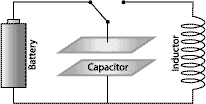
Figure 1: Switch
position for charging the capacitor
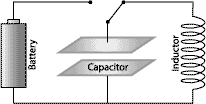
Figure 2: Switch position for making the circuit oscillate
We can make a circuit oscillate at its
natural frequency by first storing electrical energy or, in other
words, charging its capacitor as shown in Figure 1. When this is
accomplished the switch is thrown to the position shown in Figure 2.
At time = 0 all of the electrical energy is stored in the capacitor
and the current is zero (see Figure 3). Notice that the top plate of
the capacitor is charged positively and the bottom negatively. We
can't see the electrons' oscillation in the circuit but we can
measure it using an ammeter and plot the current versus time to
picture what the oscillation is like.
Note that T on our graph is the
time it takes to complete one oscillation.

Figure 3: Beginning
of oscillation
Current flows in a clockwise direction
(see Figure 4). The energy flows from the capacitor into the
inductor. At first it may seem strange that the inductor contains
energy but this is similar to the kinetic energy contained in a
moving mass.
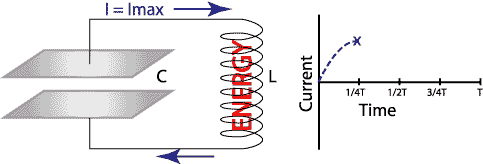
Figure 4: time = 1/4T
Eventually the energy flows back into
the capacitor, but note, the polarity of the capacitor is now
reversed. In other words, the bottom plate now has the positive
charge and the top plate the negative charge (see Figure 5).

Figure 5: time = 1/2T
The current now reverses itself and the
energy flows out of the capacitor back into the inductor (see Figure
6). Finally the energy fully returns to its starting point ready to
begin the cycle all over again as shown in Figure 3.
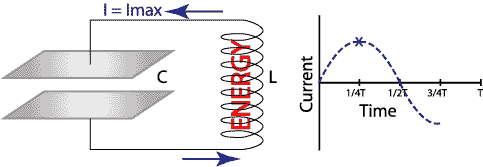
Figure 6: time = 3/4T
The frequency of the oscillation can be
approximated as follows:
f = 1 / 2π (LC)0.5
Where: f = frequency
L = Inductance
C = Capacitance
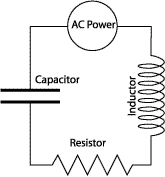
Figure 7: Resonating
circuit
In real-world LC circuits there's always some resistance which
causes the amplitude of the current to grow smaller with each cycle.
After a few cycles the current diminishes to zero. This is called a
"damped sinusoidal" waveform. How fast the current damps to zero
depends on the resistance in the circuit. However, the resistance
does not alter the frequency of the sinusoidal wave. If the
resistance is high enough, the current will not oscillate at all.
Obviously, where there's a natural frequency there's a way to excite
a resonance. We do this by hooking an alternating current (AC) power
supply up to the circuit as shown in Figure 7. The term alternating
means that the output of the power supply oscillates at a particular
frequency. If the frequency of the AC power supply and the circuit
it's connected to are the same, then resonance occurs. In this case
we measure the amplitude or size of the oscillation by measuring
current.
Note in figure 7 that we have put a resistor back in the circuit. If
there is no resistor in the circuit the current's amplitude will
increase until the circuit burns up. Increasing resistance tends to
decrease the maximum size of the current's amplitude but it does not
change the resonant frequency.
As a rule of thumb, a circuit will not oscillate unless the
resistance (R) is low enough to meet the following condition:
R = 2 (L/C)0.5
Resonance in circuits might be just a
curiosity except for its usefulness in transmitting and receiving
wireless communications including radio, television, and cell
phones. Transmitters used for sending signals are typically circuits
designed to resonate at a specific frequency called the carrier
frequency. The transmitter is then connected to an antenna which
radiates electromagnetic waves at the carrier frequency.
An antenna on the other end receives the signal and feeds it to yet
another circuit also designed to resonate at the carrier frequency.
Obviously, the antenna receives many signals at various frequencies
not to mention background noise. The resonating circuit essentially
selects the correct frequency from among all the unwanted ones.
With an amplitude modulated (AM) radio the amplitude
of the carrier frequency is modified so that it contains the sounds
picked up by a microphone. This is the simplest form of radio
transmission but is very susceptible to noise and interference.
Frequency modulated or FM radio solves many of the problems of AM
radio but at the price of higher complexity in the system. In an FM
system sounds are electronically transformed into small changes in
the carrier frequency. The piece of equipment which performs the
transformation is called a modulator and is used with the
transmitter.
In addition, a demodulator has to be
added to the receiver to convert the signal back into a form which
can be played on a speaker.
References
Physics for Scientists and Engineers
4th Edition Volume 2, Raymond A. Serway, Saunders College
Publishing, p.949
Acknowledgements
For more information about wireless
communication and the electromagnetic spectrum visit
The Hidden World of the Electromagnetic
Spectrum.
Back
to Contents
|






